What is change leadership?
Change leadership is the act of leading an organization through significant change ensuring the impacted people and stakeholders are ready, willing and able to talk on the new ways of working.
Unlike project management, which focuses on getting the solution ready and working to specification, change leadership is about ensuring your people are ready for the solution.
This means inspiring, influencing, and uniting teams with a clear vision while navigating the complex dynamics of change.
In this article, you’ll learn what change leadership is, and how it distinguishes itself from conventional management, the skills leaders need, and the impact it has on achieving successful outcomes in today’s organizations.
Key Takeaways
- Change leadership is a human-centric approach that focuses on inspiring and guiding people through change, rather than just managing processes.
- Effective change leaders create a compelling vision, foster a collaborative culture, and provide consistent support to overcome resistance and maintain momentum post-change.
- Sustainable change requires a strategic plan, stakeholder engagement, implementation of leadership models and tools, and consideration of the psychological aspects of change like trust and empathy.
Why is change leadership important
“Organizations with strong change leadership are 6 times more likely to achieve project objectives, over 5 times more likely to stay on schedule, and 2 times more likely to stay on budget.” (Source: Prosci’s Best Practices in Change Management)

Driving transformational changes within organizations, change leadership adopts a human-centric approach. This is a proactive approach that distinguishes change leadership, aiming to create a united understanding of the change needed to execute strategy.
Change leadership requires adaptability: a blend of creativity with strategic understanding. To successfully lead employees and stakeholders through change, change leaders must inspire, influence, and direct the change process at both an individual and organizational level.
A distinct approach sets successful change leaders apart. Sure, the solution needs focus, but ensuring the people are ready for the solution also requires dedicated focus.
A change leader must set the tone and embrace change themselves first serving as an avatar for the rest of the organisation.
Effective change leadership is all about influencing the hearts and minds of people, leading them towards the shared vision of successful change.
The Essence of Change Leadership
Change leadership transcends traditional change management. It’s not just about rolling out a new system or implementing a new process. It’s about inspiring individuals and cultivating an environment that embraces change at all levels of an organization.
Take the case of IBM’s Transformation under Lou Gerstner. IBM’s turnaround from a near-bankrupt company to a market leader, Gerstner focused on changing the corporate culture and aligning the organization around customer needs and services rather than just hardware.
Successful change leaders are, in essence, visionaries. They lead change effectively by painting a clear picture of the desired future and inspiring their teams to strive towards that vision.
Undeniably, people-centricity forms the essence of change leadership. Successful change leaders understand that the key to effective change is not just in the systems and processes but in the people who live them every day.
They embrace a people-centric approach, valuing each individual’s contribution and ensuring everyone is on board with the proposed change. This approach fosters a collaborative culture, where everyone feels valued, heard, and inspired to contribute to the change effort.
The Distinguishing Factors
Vision is a cornerstone of change leadership. Having a clear vision is not the sole requirement of change leadership. It also involves the ability to:
- inspire and influence others to see things differently and embrace the proposed change
- set the direction for the future and aid in the creation of actionable change plans
- paint a picture of what could be, stirring up excitement and desire for change
One factor that truly distinguishes change leadership is the influence leaders wield.
They inspire others through their actions and demeanor, encouraging voluntary acceptance of changes.
This influence goes beyond just managing change processes. It involves creating a shared vision, nurturing a collaborative culture, and leading people towards achieving that vision.
In essence, the distinguishing factors of change leadership lie in the leader’s ability to inspire and influence, making change not just an organizational level mandate, but a shared vision that everyone is enthusiastic about achieving.
The Role of a Successful Change Leader
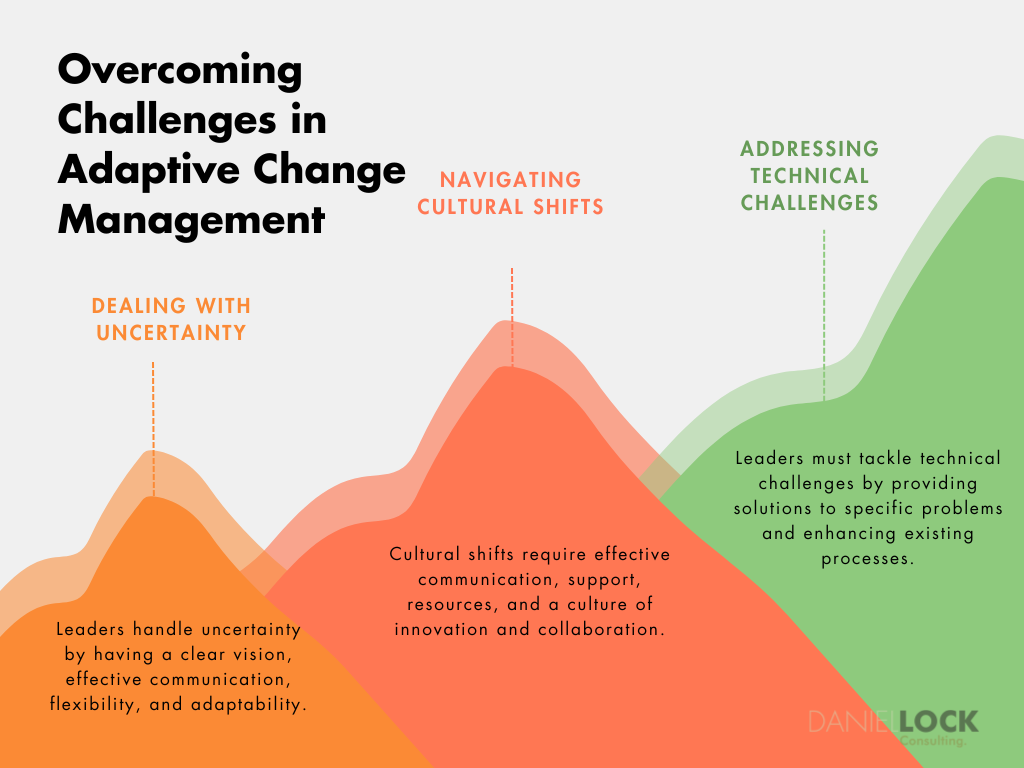
Change leadership does not just sit with the CEO, or highest paid person in the organisation. It includes anyone in a position of influence.
They are critical to successful change in order to create solutions, anticipate roadblocks, and evaluate if solutions address problems effectively.
Their role is not just limited to leading the change process; they also ensure that key people are placed in key positions and divide big projects into manageable wins.
By developing metrics and monitoring systems, they measure the progress of change initiatives, ensuring the change effort is on track and yielding the desired results.
Successful change leaders need a broad leadership skill set: They may adopt the role of agitation, innovation, or orchestration, each necessary for powering change within an organization.
They work alongside company leaders, human resources, change managers, and employees to fully integrate change, leveraging insights and feedback to make the change process smooth and effective. They are the driving force behind successful change, leading the organization towards its desired future state.
Visionary Guidance
Primarily, successful change leaders need to be visionaries.
Creating a vision is important to allow the organisation to see beyond the current circumstances. In doing so change leaders provide a clear and compelling direction that inspires stakeholders to move towards a desired future state.
A vision is not just a lofty ideal; it’s a tangible goal that everyone can work towards.
A case study for developing a vision: Ideo helps a television station reinvigorate it’s vision, mission an purpose for all
Take the case of the Connecticut Public Broadcasting Network (CPBN), who coming up to the 50 year commemoration had some tough choice and improvements to make.
But to what?
To help them with this question, they employed IDEO, the global design and innovation company to help them deign and develop the vision.
To get to the nub of this and involve as many people within and outside the organisation as possible, IDEO transformed an open space at CPBN central command into an exhibition that showed work-in-advance segments of the vision.
They included residents from the city of Connecticut as well as staff to draft a its vision, mission and purpose.
This prompted much discussion and debate, empowering the organisation to land at a solid and shared vision for its future: to be the most daring open media organization, able to investigate subjects in ways no private media business can. As well as engaging and empowering its audience to make the world a better place.


However, having a vision is not enough.
Change leaders must communicate effectively, simplifying the message and addressing stakeholders’ concerns and interests continually. They must align their behavior with the advocated vision and values to ensure coherence and reinforce the credibility and integrity of the change effort.
The development of a vision should be a collaborative process that reflects collective efforts, aligning the influence of leadership with the concerns and values of the team to facilitate a smoother transition.
While vision can provide direction and motivation, an overly rigid adherence to it can lead to inflexibility, signaling the need for balance between vision and adaptability.
Nurturing a Collaborative Culture
Within the scope of change leadership, collaboration holds paramount importance. Change leaders foster a culture of collaboration by facilitating open idea sharing and embracing diversity and inclusion.
They understand that a collaborative culture leads to more creativity, better problem-solving, and a more effective change process.
Consider Satya Nadella at Microsoft and under Nadella’s leadership Microsoft was revitalized by shifting the company culture towards growth mindset, customer obsession, and a more collaborative and open work environment, leading to significant increases in market value.
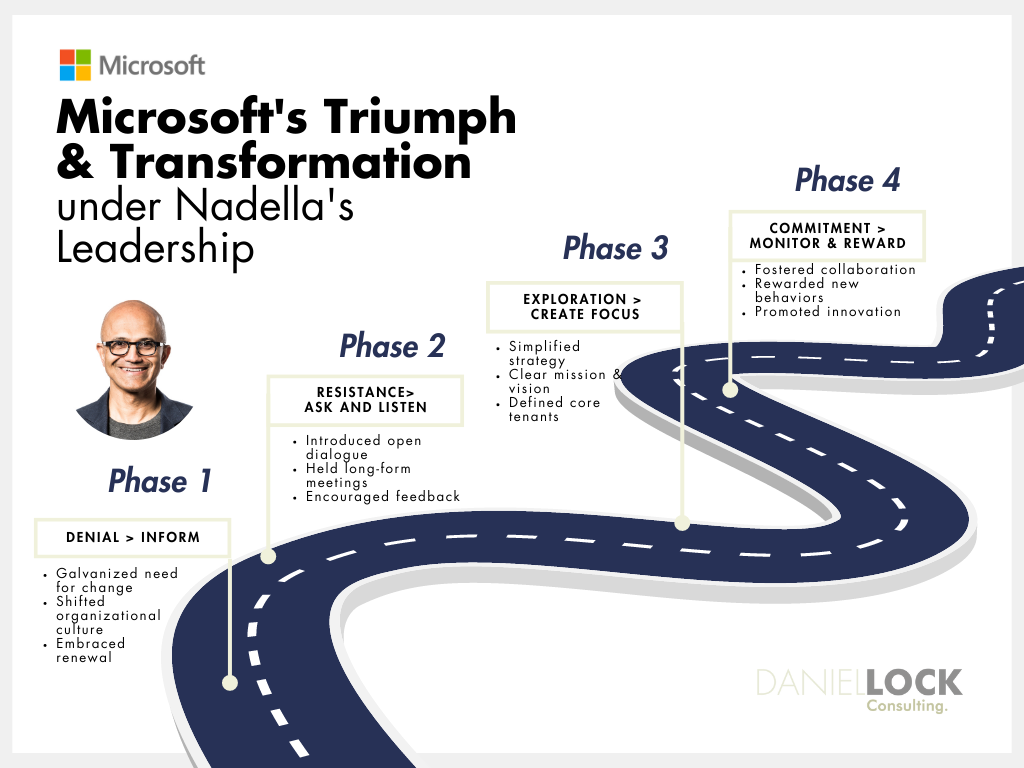
Change leaders establish effective communication practices and promote transparency to foster a culture of collaboration and teamwork.
They understand that employees feel valued when they are included early in the change process, which is supported by adaptable leadership and acknowledgment of their need for time to embrace change.
By nurturing a collaborative culture, change leaders not only ensure a smoother change process but also create an environment where innovation and creativity thrive.
But, how much value does collaboration drive in projects?
Designing collaborative sessions to bring key people together and work through the problems and opportunities will make a significant difference to your project.
Putting together a group that supports the need for change and with enough power and organizational clout to lead the change and make things happen, getting the group together to work as part of a team
A 2010 survey by McKinsey found that change project success ballooned to more than 75% when workers on the shop floor felt they were an integral part of the process of change.
Ask, who needs to be enrolled to be part of your “guiding coalition”?
Overcoming Resistance with Support
Inevitably, resistance forms a part of the change process. However, successful change leaders understand that overcoming resistance is not about bulldozing objections but about providing consistent support to help employees navigate the change.

The most difficult cause of resistance is ambiguity. Ambiguity is unavoidable in projects, but it is controllable.
Change leaders know – and expect resistance – and get out in front of it to minimise the effects of such change resistance. This requires the leader to be visible and engaging individuals regularly through communication, enhancing their desire for change, ensuring their voices are heard, and their concerns addressed
Furthermore, they understand that educating and training employees on the value of the change can mitigate resistance by demonstrating benefits to their daily experiences. By doing so, they provide consistent support throughout the change process, ensuring a successful change.
By addressing resistance directly and promoting employee participation, change leaders ensure a smoother and more successful change process.
Crafting a Strategic Plan for Lasting Change

In change leadership, the creation of a strategic plan for enduring change is crucial. It involves understanding the necessity for change, establishing shared goals, and defining priorities, timelines, tasks, and resources.
A well-crafted strategic plan ensures that the change initiative is not just a one-time event but a sustainable transformation that positively impacts the organization in the long run.
Creating a strategic plan involves a deep understanding of the organization’s current state, a clear vision of the desired future state, and a roadmap to bridge the gap between the two.
Successful change leaders devise detailed strategic plans that include clear priorities, timelines, tasks, and resources. They understand that a strategic plan is more than just a document; it’s a roadmap that guides everyone in the organization towards the shared vision of change.
Structuring the Change Initiative
Within the strategic planning process, formulating the change initiative is vital. It involves:
- Identifying the reasons for change
- Defining the desired benefits
- Monitoring progress
- Setting priorities
By clearly outlining the change initiative’s structure, change leaders ensure that everyone in the organization is on the same page and working towards the same goals.
Change leaders understand that the successful execution of a change initiative requires a clear action plan. They:
- Divide big projects into manageable wins
- Assign tasks and responsibilities
- Possibly redesign organizational processes to support the strategic objectives
- Initiate change with smaller, achievable steps to build momentum and credibility
- Monitor progress and provide regular feedback
- Ensure the change initiative stays on track and leads to sustainable outcomes.
Engaging with Stakeholders
Stakeholder engagement is integral to successful change leadership. Here are some key strategies to consider:
- Early engagement: Engage stakeholders from the beginning to transform them into change advocates.
- Customized communication: Tailor your communication to effectively share information about the change with each stakeholder.
- Stakeholder analysis: Conduct a stakeholder analysis at the outset to understand and categorize stakeholders.
- Evolving engagement plans: Develop evolving engagement plans to address the specific needs and concerns of each stakeholder.
By implementing these strategies, change leaders can enhance stakeholder engagement and increase the likelihood of successful change implementation.
Change leaders also understand the importance of appointing stakeholder change champions. These champions can help establish a strong ownership culture and ensure accountability. They also recognize the value of celebrating milestones and recognizing individual contributions, which maintain stakeholder engagement and express gratitude.
By engaging stakeholders effectively, change leaders ensure a smoother change process and greater buy-in for the change initiative.
Executing the Change: Tactics and Tools
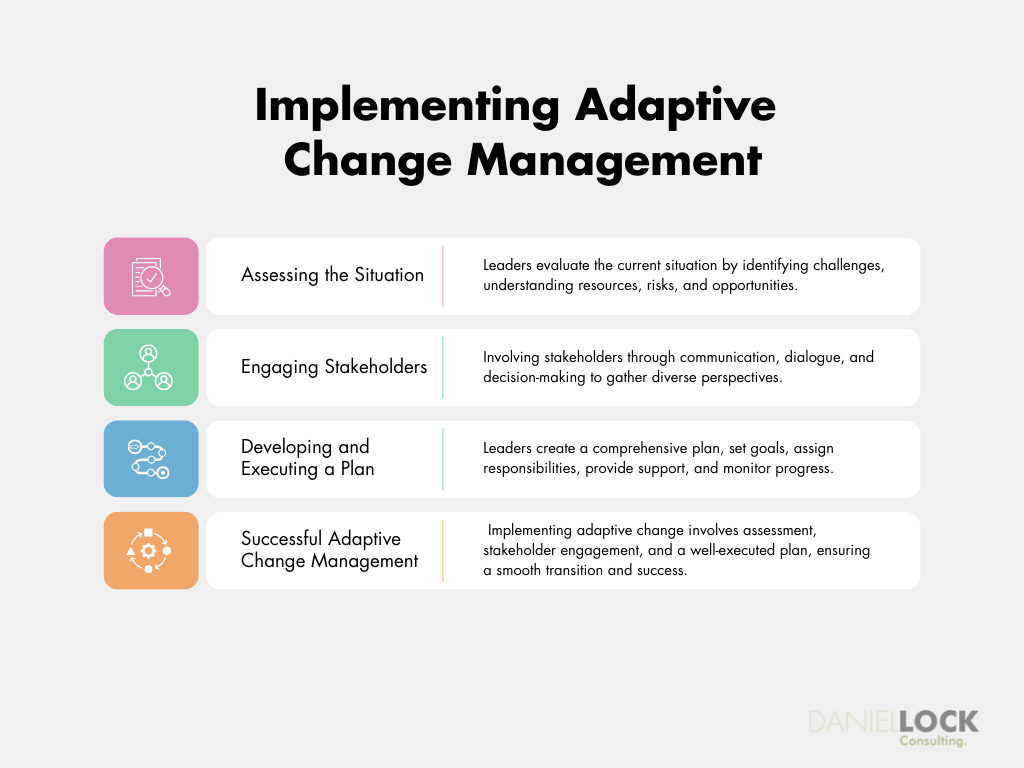
The execution phase is when the theoretical change becomes practical. Successful change leaders understand that the execution of change requires a blend of tactics and tools, all aimed at ensuring the smooth implementation of the change initiative.
Change leaders are responsible for:
- Assessing progress
- Orchestrating the change process
- Ensuring the adoption of the change plan
- Guiding through various scenarios with agility
- Maintaining leadership throughout the change
By leveraging effective leadership models and change mechanisms, change leaders drive the change process, ensuring that the organization successfully navigates the path of transformation and emerges stronger and better prepared for future challenges.
Utilizing Change Mechanisms
To drive the change process, change leaders employ various change mechanisms. These include:
- Readiness checklists
- Tailored training programs
- Consistent and clear communication
- Technology like internal knowledge bases
By utilizing these change management processes, change leaders can ensure that everyone in the organization is well-equipped to navigate the organizational change process.
Effective communication about the necessity and benefits of change, as well as providing adequate support, are key aspects of exercising influence in change leadership.
Training programs tailored to the nature of change, as well as initiatives for knowledge sharing and ongoing support, are essential for preparing employees for organizational transformations.
By comparing the benefits of a new strategy to a team manager’s game plan, emphasizing alignment with organizational goals, and encouraging creative collaborative efforts, leaders can foster an innovative climate for managing change.
Leading Beyond the Project: Ensuring Sustainable Change

Ensuring sustainable transformation, rather than a one-off event, is the goal of leading beyond the project. This process involves integrating new improvements into employees’ daily work routines, maintaining momentum, and evaluating success and learning from experience.
Successful change leaders understand that for change to be sustainable, it needs to be integrated into the organization’s daily routines.
They maintain momentum by continuously communicating about progress, celebrating milestones, and sharing success stories. They understand that maintaining momentum is crucial for the success of long-term change initiatives.
Maintaining Momentum Post-Change
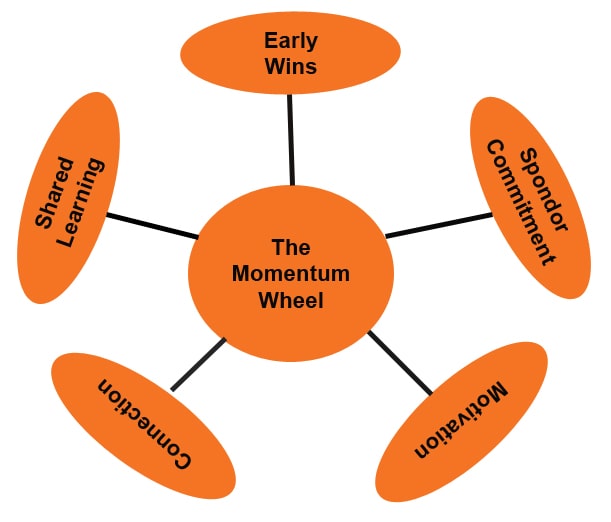
For long-term change initiatives to succeed, it’s crucial to maintain momentum after the change. It involves continuous communication about progress, celebrating milestones, and sharing success stories.
By maintaining momentum, change leaders ensure that the organization continues to move forward towards its vision, even after the initial change initiative has been completed.
Successful change leaders, who are also successful leaders in their own right, understand that momentum is built on success.
They celebrate short-term wins, recognize individual contributions, and share success stories to keep the team motivated and engaged.
By maintaining momentum, they ensure that the team continues to strive towards the vision, keeping the spirit of change alive long after the initial project has been completed.
Evaluating Success and Learning from Experience
A vital component of the change process is evaluating success. It involves observing behavioral changes, tracking adherence to project timelines, and assessing the efficiency of the change management process.
By evaluating success, change leaders can measure the practical impact of the change initiative and determine the financial return on investment.
Learning from experience is another vital aspect of the change process. Change leaders understand that every change initiative provides valuable insights and lessons that can be used to improve future change efforts.
They take the time to reflect on the change process, learn from their experiences, and use these lessons to drive future success.
The Psychological Aspect of Leading Change
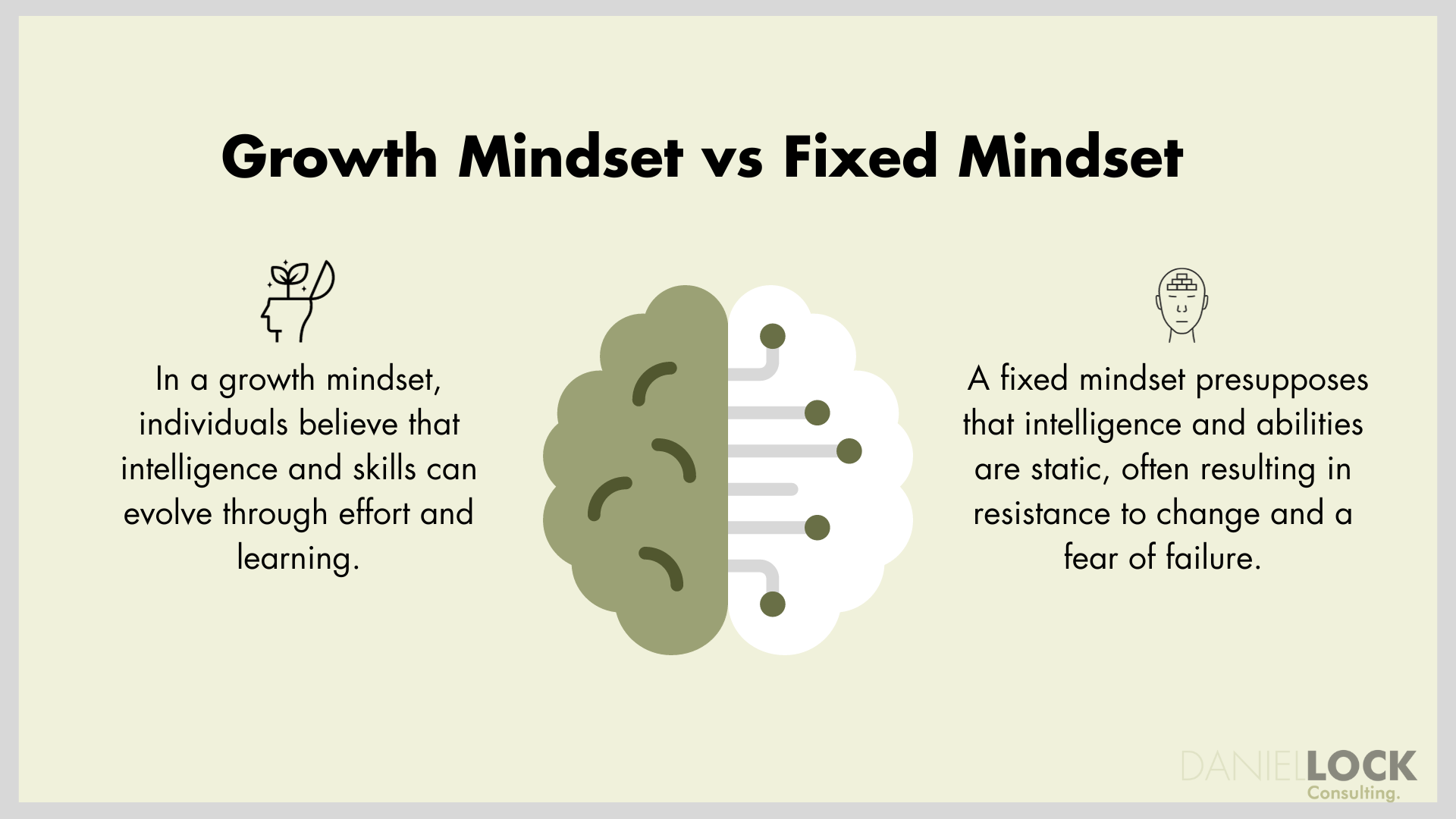
Although often overlooked, the psychological aspect plays a crucial role in successful change leadership. It involves:
- Considering the emotional needs of employees
- Managing critical paradoxes
- Balancing the need for swift, urgent action with the necessity for realistic patience.
Change leaders understand that for change to be successful, they need to address both the big picture and the individual impact.
They recognize that while organizational transformations and goals are important, they should not overshadow the personal impacts on employees.
By considering the emotional needs of employees in decision-making, they align organizational changes with the well-being of employees, thereby supporting a more holistic approach to change.
Building Trust and Empathy
On the psychological side of change leadership, building trust and empathy is vital. Change leaders understand that trust is the foundation of any successful change effort. They strive to create high-trust environments where employees feel safe and secure, enabling them to:
- Be more creative
- Be more productive
- Perform their best work
- Be aligned with the organization’s purpose.
Change leaders exercise emotional intelligence in their interactions with employees. They use active listening, patient conflict resolution, and mentorship to build trust and healthy relationships with employees.
By building trust and empathy, change leaders ensure a smoother change process and a more engaged and committed team.
“You need to start demonstrating some successes asap to develop credibility, and momentum, to start to win over the skeptical..”
-John Kotter, direct quote to Daniel from
Change Management expert tips

Addressing the Big Picture and Individual Impact
Change leaders must master the delicate balancing act of addressing both the larger perspective and individual impact. They understand that while the big picture is important, it should not overshadow the individual impact.
They strive to ensure that organizational transformations do not overshadow the personal impacts on employees, striving for a balance between the two.
Change leaders also understand the need to manage critical paradoxes, such as the need for swift, urgent action against the necessity for realistic patience to accommodate people’s adaptation processes during change. By addressing both the big picture and individual impact, change leaders ensure a smoother and more successful change process.
Summary
Successfully navigating this sea of change requires effective change leadership. Change leadership is a human-centered approach that focuses on inspiring individuals and cultivating an environment that embraces change at every level of the organization.
It involves creating a clear and compelling vision, nurturing a collaborative culture, overcoming resistance with support, crafting a strategic plan for lasting change, and executing the change effectively using various tactics and tools.
Change leaders play a critical role in driving organizational change. They are visionaries who inspire others to embrace the change.
They are innovators who create solutions and anticipate roadblocks. They are orchestrators who ensure the adoption of the change plan and guide the organization through various scenarios with agility.
By leveraging effective leadership models and change mechanisms, they drive the change process, ensuring that the organization successfully navigates the path of transformation and emerges stronger and better prepared for future challenges.
Frequently Asked Questions
What are the 4 steps of change leadership?
Change leadership involves four core steps: preparing for change, initiating change, putting change in place, and stabilizing change.
Why is change leader important?
Change leaders are important because they drive transformative impact across sales, operations, and employee engagement. They foster innovation, rectify inefficiencies, and promote a positive environment, ensuring smooth transitions, adaptability, and organizational resilience.
What are the characteristics of change leadership?
Change leadership requires vision, coalition building, communication skills, interpersonal skills, motivation, and a big picture mindset. Good listening and facilitation, along with motivation, are crucial for leading a successful change strategy.
What is the role of a successful change leader?
The role of a successful change leader is to innovate solutions, anticipate obstacles, evaluate solutions, place key individuals strategically, and break big projects into manageable wins. They also establish metrics and monitoring systems to measure progress.
How important is a strategic plan in change leadership?
Having a strategic plan in change leadership is crucial. It helps ensure that the change is not just a short-term fix, but a lasting transformation that benefits the organization in the long run.


